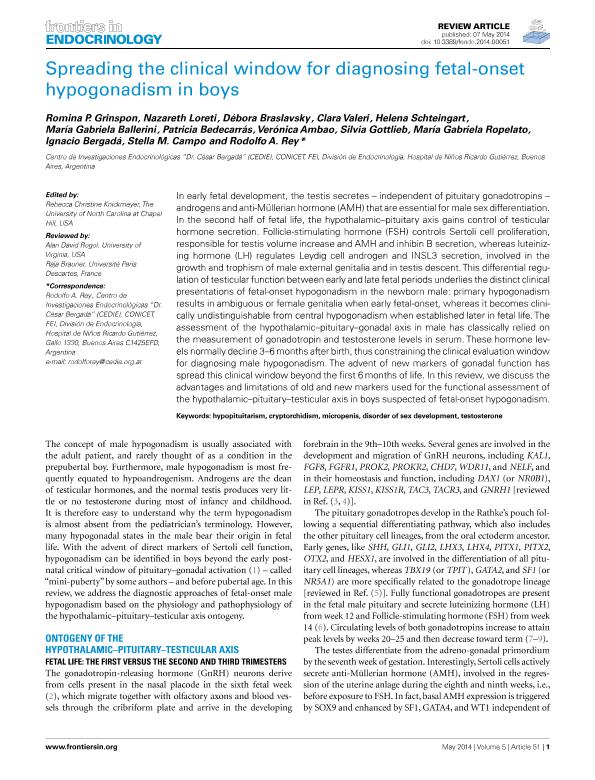Artículo
Spreading the clinical window for diagnosing fetal-onset hypogonadism in boys
Grinspon, Romina ; Loreti, Rosana Nazareth
; Loreti, Rosana Nazareth ; Braslavsky, Debora Giselle
; Braslavsky, Debora Giselle ; Valeri, Clara
; Valeri, Clara ; Schteingart, Helena Fedora
; Schteingart, Helena Fedora ; Ballerini, Maria Gabriela; Bedecarras, Patricia Gladys
; Ballerini, Maria Gabriela; Bedecarras, Patricia Gladys ; Ambao, Veronica Ana
; Ambao, Veronica Ana ; Gottlieb, Silvia Elisa
; Gottlieb, Silvia Elisa ; Ropelato, Maria Gabriela
; Ropelato, Maria Gabriela ; Bergadá, Ignacio
; Bergadá, Ignacio ; Campo, Stella Maris
; Campo, Stella Maris ; Rey, Rodolfo Alberto
; Rey, Rodolfo Alberto
 ; Loreti, Rosana Nazareth
; Loreti, Rosana Nazareth ; Braslavsky, Debora Giselle
; Braslavsky, Debora Giselle ; Valeri, Clara
; Valeri, Clara ; Schteingart, Helena Fedora
; Schteingart, Helena Fedora ; Ballerini, Maria Gabriela; Bedecarras, Patricia Gladys
; Ballerini, Maria Gabriela; Bedecarras, Patricia Gladys ; Ambao, Veronica Ana
; Ambao, Veronica Ana ; Gottlieb, Silvia Elisa
; Gottlieb, Silvia Elisa ; Ropelato, Maria Gabriela
; Ropelato, Maria Gabriela ; Bergadá, Ignacio
; Bergadá, Ignacio ; Campo, Stella Maris
; Campo, Stella Maris ; Rey, Rodolfo Alberto
; Rey, Rodolfo Alberto
Fecha de publicación:
05/2014
Editorial:
Frontiers
Revista:
Frontiers in Endocrinology
ISSN:
1664-2392
Idioma:
Inglés
Tipo de recurso:
Artículo publicado
Clasificación temática:
Resumen
In early fetal development, the testis secretes – independent of pituitary gonadotropins – androgens and anti-Müllerian hormone (AMH) that are essential for male sex differentiation. In the second half of fetal life, the hypothalamic–pituitary axis gains control of testicular hormone secretion. Follicle-stimulating hormone (FSH) controls Sertoli cell proliferation, responsible for testis volume increase and AMH and inhibin B secretion, whereas luteinizing hormone (LH) regulates Leydig cell androgen and INSL3 secretion, involved in the growth and trophism of male external genitalia and in testis descent.This differential regulation of testicular function between early and late fetal periods underlies the distinct clinical presentations of fetal-onset hypogonadism in the newborn male: primary hypogonadism results in ambiguous or female genitalia when early fetal-onset, whereas it becomes clinically undistinguishable from central hypogonadism when established later in fetal life. The assessment of the hypothalamic–pituitary–gonadal axis in male has classically relied on the measurement of gonadotropin and testosterone levels in serum. These hormone levels normally decline 3–6 months after birth, thus constraining the clinical evaluation window for diagnosing male hypogonadism. The advent of new markers of gonadal function has spread this clinical window beyond the first 6 months of life. In this review, we discuss the advantages and limitations of old and new markers used for the functional assessment of the hypothalamic–pituitary–testicular axis in boys suspected of fetal-onset hypogonadism.
Archivos asociados
Licencia
Identificadores
Colecciones
Articulos(CEDIE)
Articulos de CENTRO DE INVESTIGACIONES ENDOCRINOLOGICAS "DR. CESAR BERGADA"
Articulos de CENTRO DE INVESTIGACIONES ENDOCRINOLOGICAS "DR. CESAR BERGADA"
Citación
Grinspon, Romina; Loreti, Rosana Nazareth; Braslavsky, Debora Giselle; Valeri, Clara; Schteingart, Helena Fedora; et al.; Spreading the clinical window for diagnosing fetal-onset hypogonadism in boys; Frontiers; Frontiers in Endocrinology; 5; 51; 5-2014; 1-14
Compartir
Altmétricas



